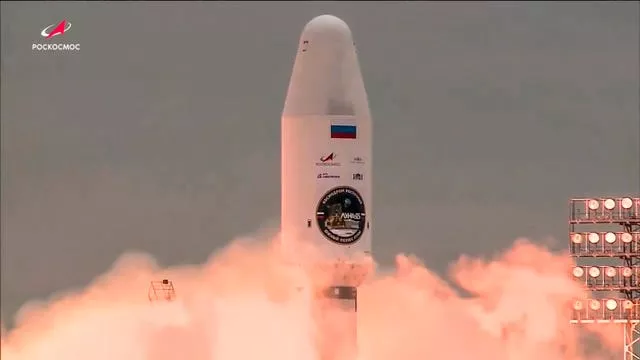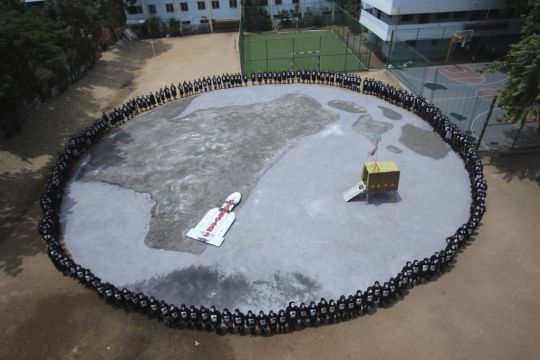India was counting down to landing a spacecraft near the Moon’s south pole on Wednesday – uncharted territory that scientists believe could hold important reserves of frozen water and precious elements.
A lander with a rover inside was orbiting before attempting to touch down on the lunar surface, creating an agonising wait for India’s space scientists in the southern city of Bengaluru.
India is making its second attempt in four years to join the United States, the Soviet Union and China in achieving the landmark.
Chandrayaan-3 Mission:
All set to initiate the Automatic Landing Sequence (ALS).
Awaiting the arrival of Lander Module (LM) at the designated point, around 17:44 Hrs. IST.
Upon receiving the ALS command, the LM activates the throttleable engines for powered descent.
The… pic.twitter.com/x59DskcKUV— ISRO (@isro) August 23, 2023
Advertisement
India unexpectedly got into a race with Russia, which had planned to land its Luna-25 spacecraft in the same region on Monday.
But Luna-25 crashed into the Moon after it spun into an uncontrolled orbit.
It would have been the first successful Russian lunar landing after a gap of 47 years.
Russia’s head of the state-controlled space corporation Roscosmos attributed the failure to the lack of expertise due to the long break in lunar research that followed the last Soviet mission to the Moon in 1976.
The highly anticipated Indian Moon landing will be watched by thousands of people crowding around televisions in offices, shops, restaurants and homes.
Many prayed on Tuesday for the success of the mission, with oil lamps on the river banks, temples and religious places, including the holy city of Varanasi in northern India.
India’s Chandrayaan-3 – “moon craft” in Sanskrit – took off from a launchpad in Sriharikota in southern India on July 14, heading for the far side of the Moon.
The mission follows a failed effort nearly four years ago to land a rover on the lunar surface to carry out scientific experiments.

The Indian Space Research Organisation (Isro) said in a statement: “India’s pursuit of space exploration reaches a remarkable milestone with the impending Chandrayaan-3 mission, poised to achieve a soft landing on the lunar surface.
“This achievement marks a significant step forward for Indian science, engineering, technology, and industry, symbolising our nation’s progress in space exploration.”
A successful Chandrayaan-3 landing would be monumental in fuelling curiosity and sparking a passion for exploration among youth, the organisation said.
“It generates a profound sense of pride and unity as we collectively celebrate the prowess of Indian science and technology. It will contribute to fostering an environment of scientific inquiry and innovation.”
The six-wheeled lander and rover module of Chandrayaan-3 is configured with payloads which will provide data to the scientific community on the properties of lunar soil and rocks, including chemical and elemental compositions.

India’s previous attempt to land a robotic spacecraft near the Moon’s little-explored south pole ended in failure in 2019.
It entered the lunar orbit but lost touch with its lander, which crashed while making its final descent to deploy a rover to search for signs of water.
According to a failure analysis report submitted to Isro, the crash was caused by a software glitch.
The 140-million US dollar (£110 million) mission in 2019 was intended to study permanently shadowed moon craters that are thought to contain water deposits and were confirmed by India’s Chandrayaan-1 orbiter mission in 2008.
Isro said it has perfected the art of reaching the Moon, “but it is the landing that the agency is working on”.
Chandrayaan-3 Mission:
The mission is on schedule.
Systems are undergoing regular checks.
Smooth sailing is continuing.
The Mission Operations Complex (MOX) is buzzed with energy & excitement!
The live telecast of the landing operations at MOX/ISTRAC begins at 17:20 Hrs. IST… pic.twitter.com/Ucfg9HAvrY— ISRO (@isro) August 22, 2023
Numerous countries and private companies are in a race to successfully land a spacecraft on the lunar surface.
In April, a Japanese company’s spacecraft apparently crashed while attempting to land on the Moon.
An Israeli non-profit organisation tried to achieve a similar feat in 2019, but its spacecraft was destroyed on impact.
With nuclear-armed India emerging as the world’s fifth-largest economy, Prime Minister Narendra Modi’s nationalist government is eager to show off the country’s prowess in security and technology.







